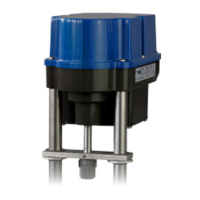After successful commissioning, check the found or adjusted stroke by comparing the set value and the valve
position.
In case of unsuccessful commissioning the green LED is flashing quickly. Please check valve mounting.
For commissioning, a stroke of at least 1 mm in direction “close with force” is required before the actuator has
reached its mechanical stop. Furthermore, the actuator must be able to perform a stroke of at least 5 mm.
10.7 Manual operation
Push button B1 and B2 simultaneously for minimum 3 seconds to change to manual operation mode.
Push button B1 to retract valve stem.
Push button B2 to extend valve stem.
Push button B1 and B2 simultaneously for minimum 3 seconds to exit from manual operation mode.
11. Operation
All internal parameters, like required motor torque, actual position, functional status, etc., are being permanently
monitored during operation of the actuator. This ensures that the actuator positions with optimal accuracy, and
always closes the valve tightly.
Cut-off in end positions
During operation the cut-off in end positions is realized for the one end position at the position found/chosen and
for the other end position via force depending on the settings for the DIP switch S2.1 (see chapter 7.2 Operating
direction). The actuator drives to the end position defined by force with a minimum shut-off window of 3%.
12. Commissioning
Open the cover (see chapter 8.), put the actuator on the valve (see chapter 7.), connect the
electric supply (see chapter 9.).
Perform automatic (see chapter 10.5) or manual (see chapter 10.6).
Close the cover.
The electrical connection and commissioning with mains voltage applied may only be
carried out by trained specialist personnel!
Do not touch any connection lines during commissioning!
13. Maintenance
The actuators are maintenance-free if used under the operating conditions as designated in the data sheet. The
gearboxes are lubricated for life and do not require further lubrication.
Caution!
During maintenance and repair the actuator must not be operated
electrically.
13.1 Cleaning
The actuators should be cleaned dryly. Do not use abrasive cleaning agents or cleaning products containing solvents
as the labelling of the safety stickers and the type plate might become illegible. Do not operate the actuator during
the cleaning process.

